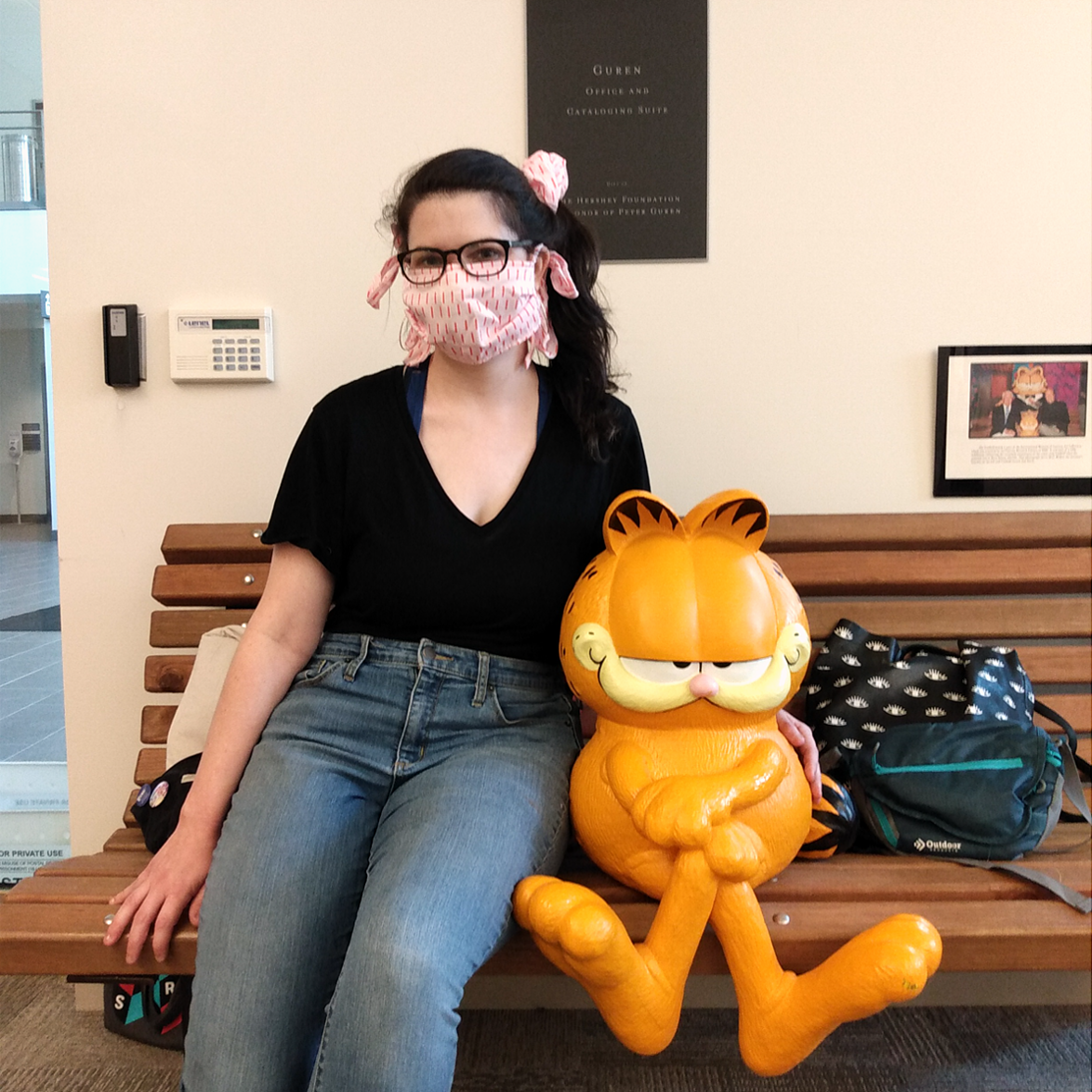
Audra Stang is a cartoonist living in Thorndale, PA, who grew up in Greensboro, NC. Her one-person anthology, The Audra Show, collects autobiographical comics and stories about the inhabitants of the fictional town of Star Valley.
I’ve known Audra for several years. We mostly talk online, but occasionally see each other at comic events. Audra and I both got art degrees from the same school, so our friendship is based not just around comics but around the fact that we ate in the same Arby's a couple decades apart.
After sharing a table with Audra at Noice in Norfolk, I thought she would be fun to interview. I conducted the interview via Google Docs in April and May of 2022.
-Andrew Neal
* * *
ANDREW NEAL: Audra, hey! It was great tabling with you at Noice earlier this year. It was busy and loud enough that we couldn’t talk as much as I would like, so I’m excited about this. How’s it going?
AUDRA STANG: It’s going well! I just got a raise at my embroidery job on Friday because I learned how to use the one-head machines.
That’s great! I appreciate you bringing up your day job, as it’s something I think is missing from a lot of discussions about making art. I’ll get back to that later, but for now let’s start at the beginning. You have been an artist since you were a kid, and I get the idea it was very important to you early on. How young were you when you decided you wanted to make comics?
I was about four or five years old; I saw an episode of Reading Rainbow about making your own newspaper, and I was drawn in because both of my parents delivered newspapers. There was a live action segment with Ray Billingsley, who draws the newspaper strip Curtis, where he takes the viewer through the process of making a comic. I saw that, and I thought “I want to do that,” and then I did everything I could to do that.

Wow, so it was early for you! It also sounds like the big catalyst was when you learned something about the process. Were there comics you were reading at that point that you enjoyed?
Yeah, and it was twofold because I was interested in both the drawing process and the printing process, especially seeing how the different colors of ink were layered to create a complete image… anyway, until about fifth grade, the only comics I read were Captain Underpants, comics in magazines like Disney Adventures and Nickelodeon, and the newspaper comics. My favorite newspaper comic was Garfield because I loved cats—Heathcliff wasn’t in my newspaper—but I read every comic that they did print.
Newspaper comics are a lot of people's introduction to comics! Were you thinking in terms of making comic strips, then, since they were what you’d read?
Not quite - I made picture books, probably because they were what I was reading at the time, haha. Like in early elementary school. I really liked making props for whatever imagination game or story I was into at the time and acting it out, and if I was doing that with other kids I would be really obnoxious and bossy about it. So I was thinking about stories and sequences, and over time came to realize that comics gave me total creative control because I could be all of the actors, the writer, the set designer, the prop maker…
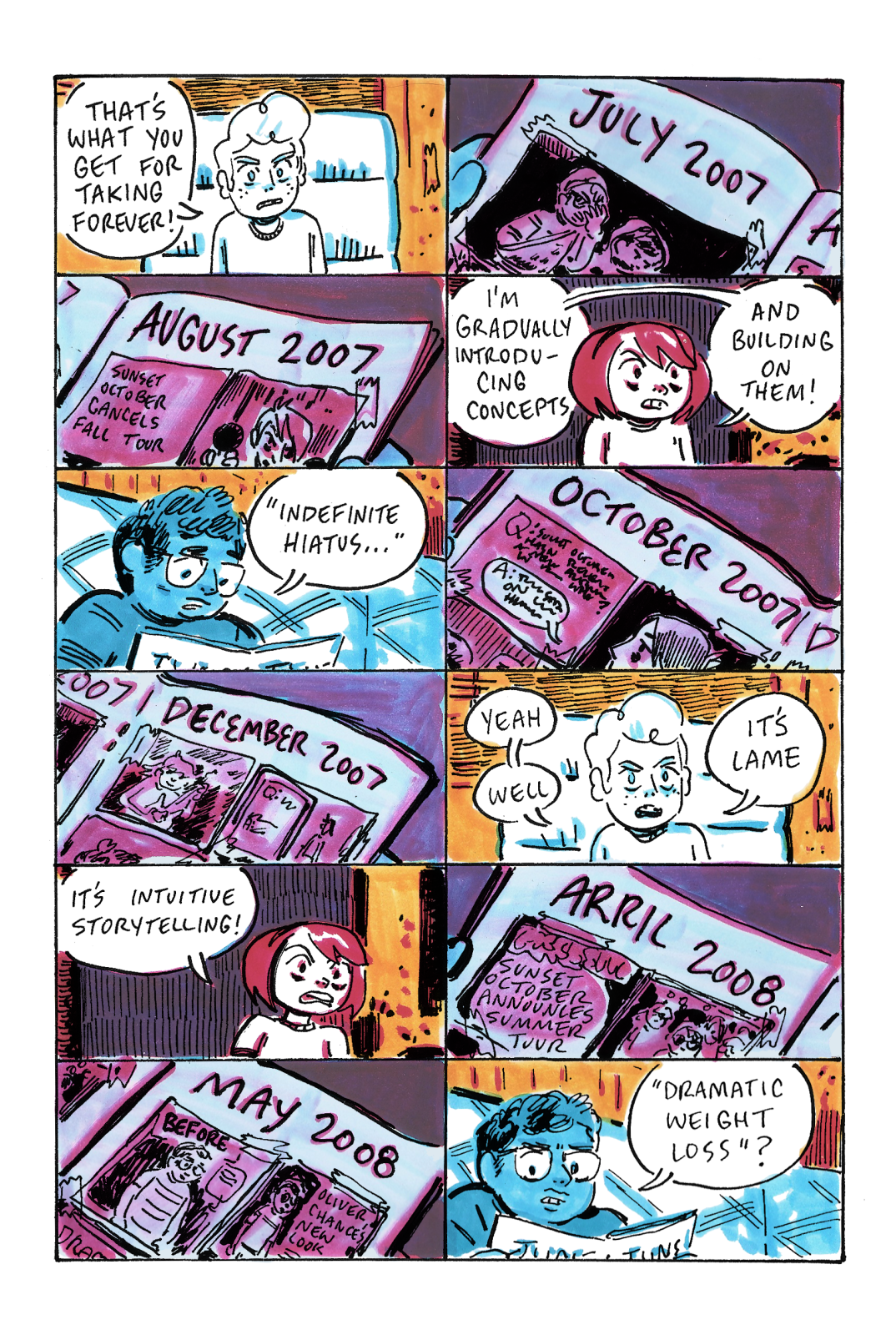
This is a little sideways from what you’re saying about designing props, but I think for a lot of people, drawings of characters that will in theory be a part of a comic are a way to try to get going when making the comic itself feels intimidating. These days a lot of people call characters like that OCs [Original Characters]. Were you involved in online communities based around OCs?
I was, but by that time I had already been making my own comics for a few years. I was in seventh grade and started making OCs for roleplaying forums online. I was into the Warriors series, which are adventure books about clans of feral cats. So I had a cat character to play Warriors, like I’d write a paragraph about what my cat was doing and respond to other peoples’ cat paragraphs, haha. I also enjoyed “gifted boarding school” roleplays which were kind of like X-Men without capes, and the characters never actually went to class.
I know you’re also interested in animation. Were you also into cartoons at this time?
Of course… the TV was always on growing up. I also had trouble sleeping 'cause I was an anxious kid, so I would end up watching all of the old cartoons they showed late at night in addition to the new cartoons that aired during the day. I didn’t realize it at the time, but I had favorites - like I really liked cartoons Chuck Jones had worked on, but I didn’t connect the dots until college. And of course I watched anime too. I was in elementary school when Pokémon first came to the U.S. and [I] had a Pokédex book. So I made my own book called My Cat Guide that was hundreds of illustrations of different breeds of “Angel Cats” that accumulated over the years [because] I was into drawing them. Like “Water Cat”, “Fire Cat”, and as time went on the cats had to get more niche, like “Brightness Cat”, “Little Water Cat”, haha.
I think the equivalents to a Pokédex for me as a kid were The Official Handbook of the Marvel Universe and DC Comics’ Who’s Who. I definitely copied those formats when drawing my own little dudes. So were you as interested in making cartoons as you were in making comics?
Yes, because I thought of both comics and animation as cartoons… like I knew Craig Bartlett was the showrunner for Hey Arnold! and also drew Arnold comics for Nick Magazine. I imagined myself doing that with my own stories. As I got older and learned more about animation, I realized that I was more interested in being a storyboarder than a character animator. Like in college my goal after graduation was to be a storyboarder on a board-driven show.
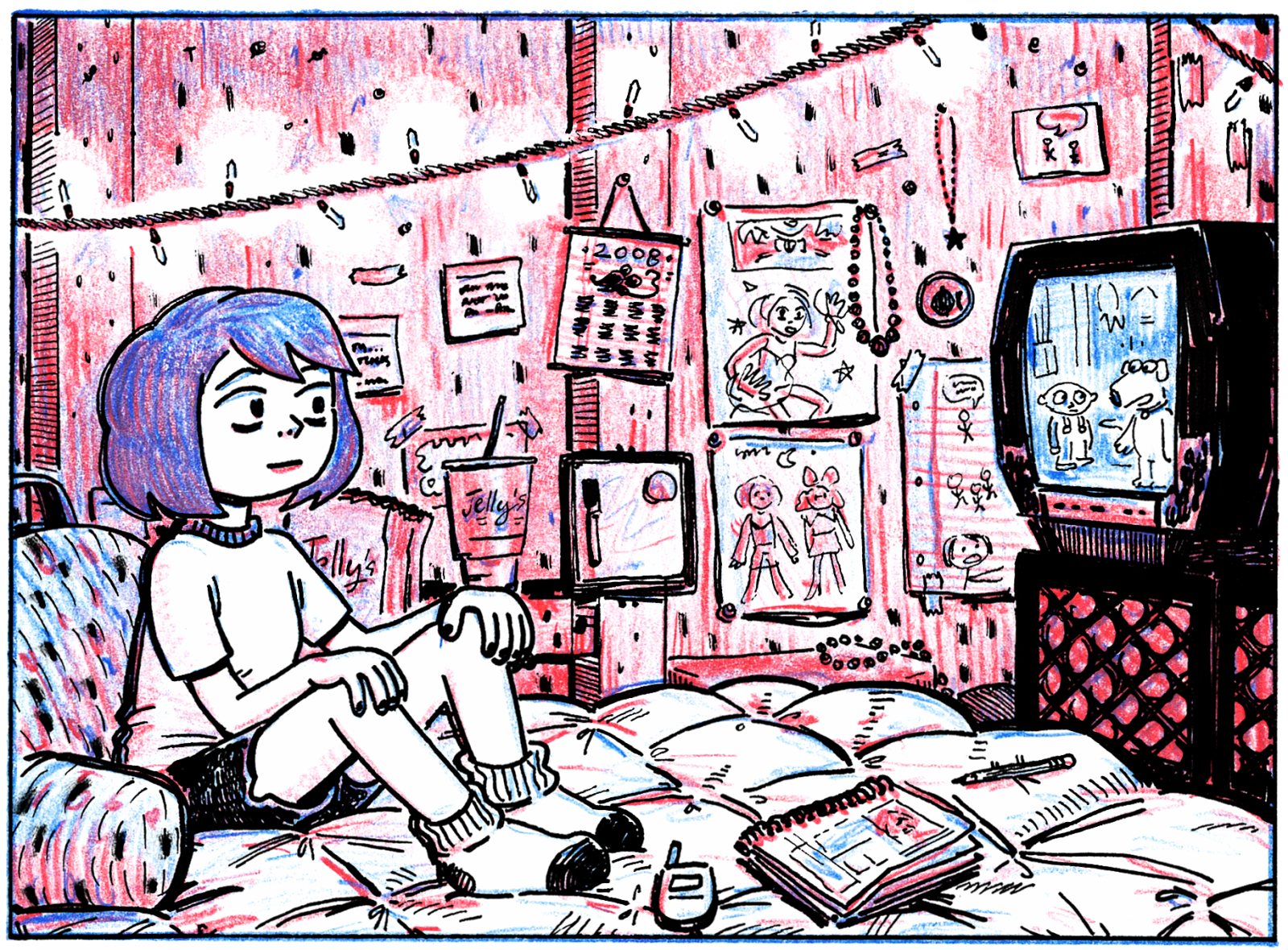
Alright, so by the time you were in college, you were making comics and wanted to work in animation. Was there a point at which you switched to having comics as your primary goal, or is comics just sort of what happened? Do you still want to work in animation?
Well, I don’t think I thought of it as an either/or situation, more like I had this misconception that I wouldn’t be able to stay a cartoonist if I didn’t have a day job cartooning. And I thought animation was where I would find that job. At some point, I saw American Splendor—the Harvey Pekar biopic—and I was like, “Oh, okay, I just have to keep the lights on, and I can make cartoons the rest of the time.” It’s not that simple, obviously, but I hadn’t seen it that way before.
Like, Derek M. Ballard did this comic recently—cartoon war journal 3—and one of the lines is about how “people like us” don’t get to make movies, tv, etc., so it gives us all these false expectations. “People like us” being working class people, you know, so I had been thinking it’s Willy Wonka and animation would be my golden ticket to financial stability. The joke is that the animation industry is awful in a lot of the ways that the restaurant industry is, from what I understand.
Working in animation would depend on a lot of different things… I think of it like cooking or embroidery, like whatever skill that can yield me the most income for the least amount of time and hand destruction is what I would choose.
Ballard’s stuff is great, yeah! This definitely ties into my thoughts on day jobs that I mentioned at the top of the interview. It seems like it’s becoming more common for cartoonists to speak openly about the fact that many (most?) of them have day jobs. It’s tough to make a living cartooning, and I think that’s important to talk about. There’s a fine line between wanting to encourage people to follow their dreams and giving them unrealistic expectations.
Yeah, I mean, a SCAD [Savannah College of Art and Design] representative came to my high school and did a presentation and I bought it and really wanted to go there. And now I’m glad I didn’t because one year there would have cost more than the entire degree I did get.
Before we get more in-depth about how you make your comics, would you like to talk a little bit about what they’re about?
Oh man, I always struggle with this one… like some version of Star Valley has existed since it was actually 2008, so initially I was just writing things that I could relate to or having fun with my friends. Like a lot of my parents’ newspaper subscribers were the parents of my wealthier classmates, and I knew that we relied on their tip checks to keep our lights on, and then I’d go to school and get roasted for wearing “old” clothes. So I wanted to write about characters who experienced stuff like that. And I had lived in Greensboro my whole life until I moved to Pittsburgh, so seeing all of these connections between people across time was something I wanted to write about too.

Star Valley feels like a fully-planned world, but how much of what you do is planned in advance and how much of it is figured out on the fly?
It’s more planned than not, but stuff I do on the fly often plants the seeds for something I plan later. The general, overarching story beats are planned, but what is actually written and drawn in the panel is finalized at the last minute. I don’t think I could work from a very exact script that described everything in minute detail; I would get bored. So I draw out a lot of versions of a specific scene knowing my general goal, and choose what happens based on that.
So you draw multiple versions of what might happen? I assume these are sketches or thumbnails as opposed to finished art? Or are there entire alternate universes out there that you’ve drawn?
For the most part, sketches and thumbnails. I drew two finished versions of Owen’s first meeting with Margaux. The second take is the fifth issue of The Audra Show and the first was a comic I drew at the beginning of 2017, before I drew the first issue of The Audra Show. It helped me flesh out Owen and Margaux as characters, but otherwise I didn’t feel like it was a very good comic.
Similarly, I might shelve a scene because it doesn’t fit right with whatever I’m working on at the time, but I might find a good place for it later. I try to consider how a comic would read both to a serial reader and an archive reader. Sometimes it just needs more time in the oven.
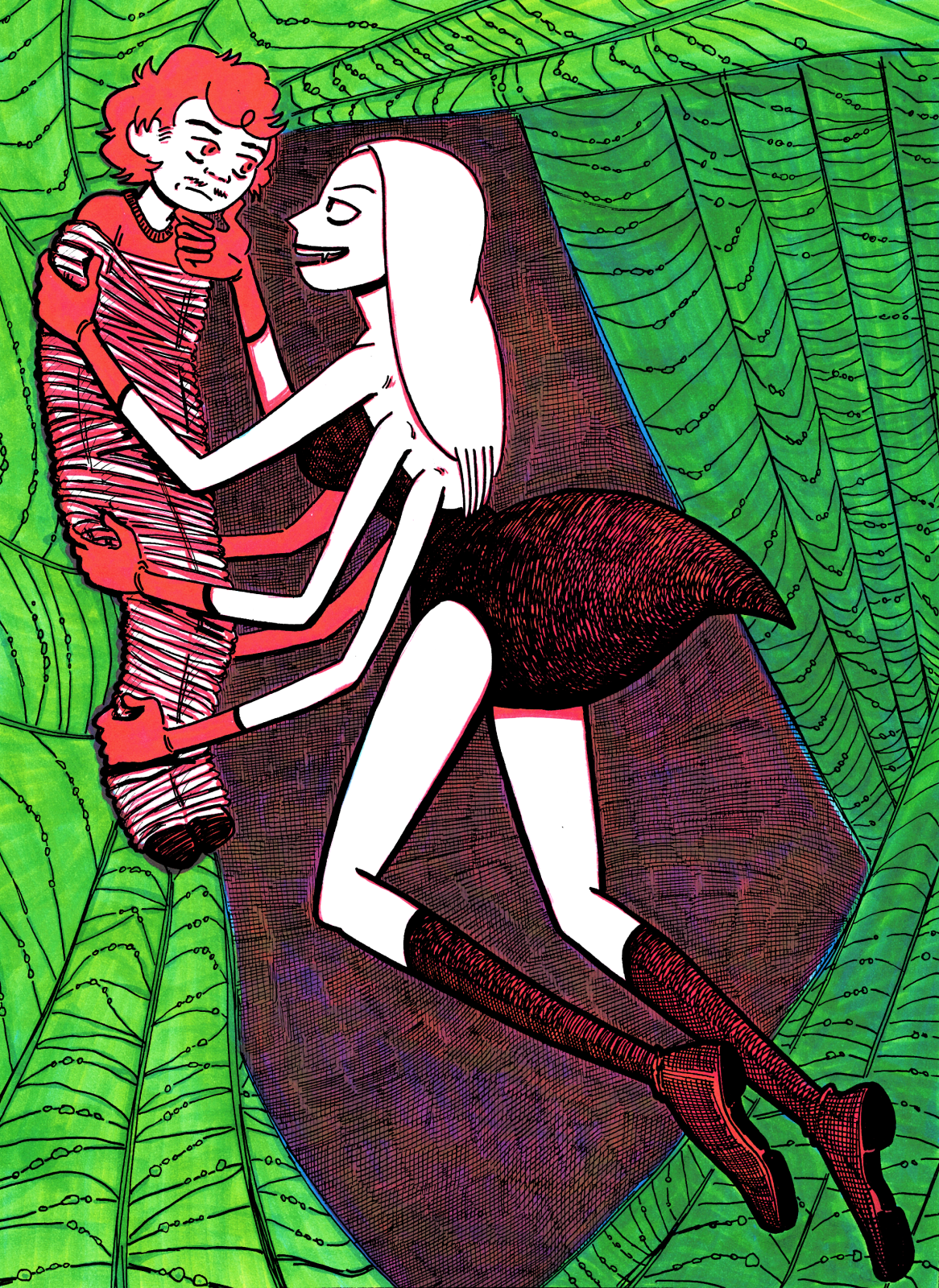
I put aside concepts and story ideas and get back to them later when I’m making comics, so I understand where you’re coming from, I think. It sounds like Star Valley is a constantly evolving thing rather than something that sprung from your head fully-formed like Athena. So where did it start? Was it with the characters, or a particular story, or the jobs that characters have?
It started with the basic storyline that Adelaide and Bryce find a musician Adelaide likes in a dumpster, and the three of them then try to figure out how he got there. There was lots of rewriting and “recasting”. At one point Owen got written out, but then I got to bring him back to play a different role. But as a result his backstory totally changed, so I made comics to think through how he got to be who he was by the time he shows up in 2008. So that’s how I got to the 1988 stories.

I like the fact that you started with the idea of an older Owen and made comics about his earlier life to explain who he is. Working backwards from an endpoint (or at least, a later point) can teach a creator just as much about the character as it does the reader. I’m assuming Bea’s and Owen’s jobs at Jelly’s are at least loosely informed by your time in restaurants?
The origin of Jelly’s is kind of embarrassing, but it was originally going to be a Dan Pussey-type thing where the restaurant was an analogy for small press/indie comics and the people who worked there were based on cartoonists, and Owen was a new guy. I had just moved to Pittsburgh from Greensboro and was meeting cartoonists I was familiar with regularly all of a sudden, and it was exciting and intimidating.
I had worked as a busser at a restaurant in Greensboro called Danny’s, and was about to start a job at Chipotle, so I was pulling from that too, yeah. By the time I was drawing Bea I had been a back of house person at Chipotle for a while. I went in thinking I was going to be a line person talking to customers and rolling burritos based on my past experience, but I had open availability, so they made me the new morning prep person instead, and I had never used a kitchen knife before.
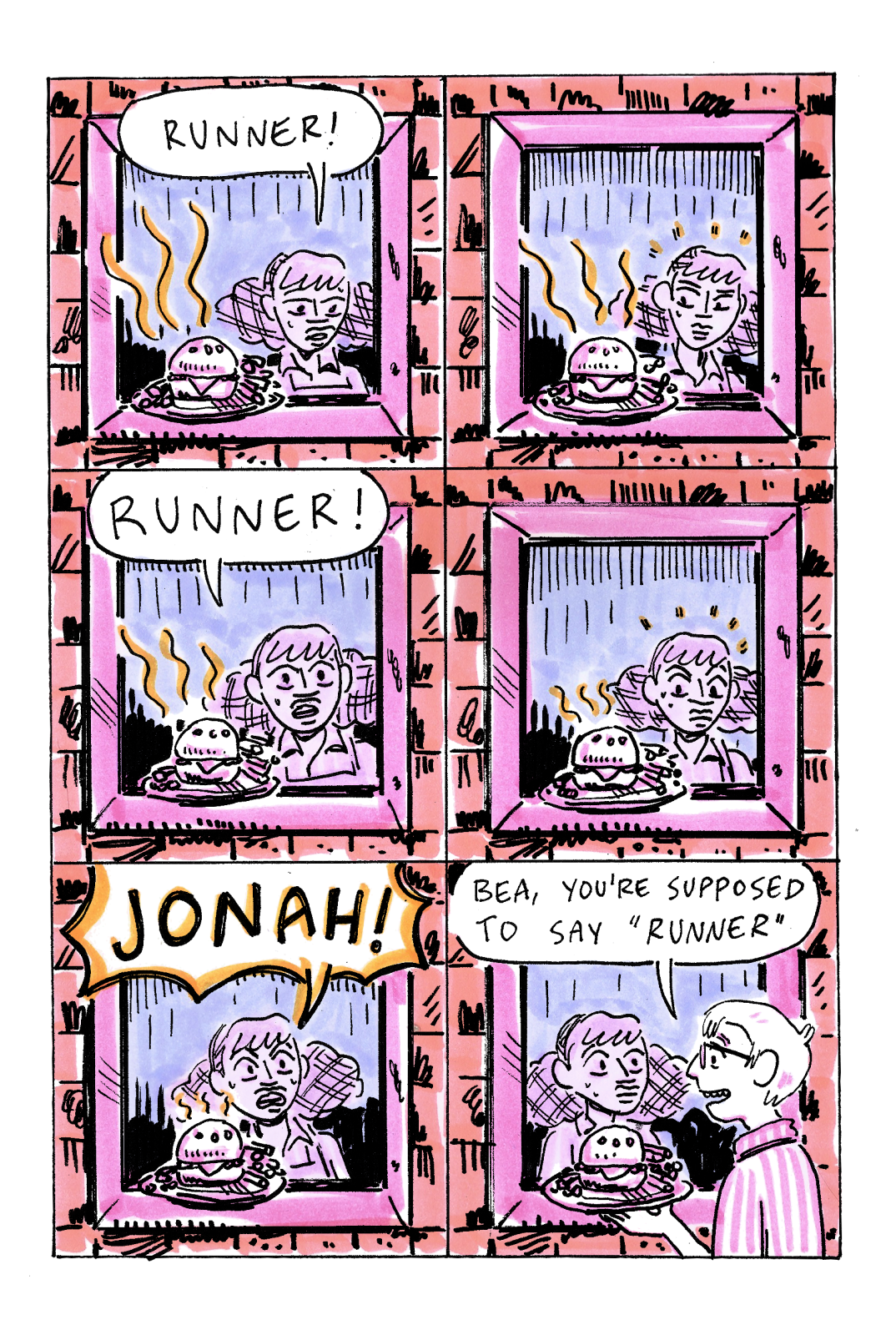
I don’t think any of what you said there should be embarrassing! What cartoonist amongst us hasn’t been inspired by the work of another cartoonist, or by their own experiences? It’s an important part of the process. And speaking of process, will you lay out how you put your pages together?
It varies, but generally once I have enough scenes I like I’ll figure out the best way to fit them together, and then fill in those gaps. But sometimes I draw a story straight ahead, thumbnailing each page as I go. Sometimes I draw part of a comic straight ahead, then plan the last 10 to 15 pages together. With "Tunnel Vision", the story I’m serializing in Rust Belt Review, it’s eight finished pages at a time. Sometimes I have a concrete endpoint, like an event I know I am heading towards, but other times I am pursuing a feeling, so it’s like adjusting the sails to get to that place.
That’s how I work too. I have a place I’m heading and some ideas of how to get there, but no full script. I’ve always thought of it as laying the track just ahead of the train but I like “adjusting the sails”! Makes it seem more serene and purposeful.
It is purposeful, yes, but I have too many irons in the fire to consider it serene, haha. Like making sure it reads in a way that is intuitive, that doesn’t unsuspend the reader’s disbelief because they are trying to figure out what panel they should read next. Making sure readers have the information they need to proceed to the next part of the story, or to understand why a character is or isn’t doing something based on the “interactions” they have had with them so far.
How much of that do you feel like you had in your pocket when you started making comics, and how much of it do you think you’ve learned by making them? The pacing and communication, I mean? I’m asking because in my experience, I learned a lot about pacing by consuming comics, but once I started making them it added a whole 'nother level of understanding.
I don't think I had very much in my pocket when I started, but because I started writing when I was young I could see what worked and what didn’t sooner. My dad would talk about comedy writers’ rooms a lot and as a kid I would write jokes and take them to him and ask if they were funny, and he was very honest about what he thought, but he’d workshop it with me… my point being that the mechanics of jokes and dialogue and how those things fit together was something I was thinking about early on.
In a similar vein, my mom would say things to me like, “A person normally isn’t reacting to what’s going on in front of them at that moment, but everything they have been through…” when we were in the car together delivering newspapers. Sorry if this isn’t answering the question, I am reckoning with why I feel like I have always thought about that stuff.
Anyway, making a lot of bad comics and writing a lot of bad stories and then reading them and seeing how they suck is a big part of it. I can’t diagnose my flaws as a cartoonist if there’s nothing for me to reference. I feel like I’m chasing the thing I see in my mind and the comics are an approximation of the better thing I want to make.

I think a cartoonist definitely has to make comics to get better at making comics! Let's talk about the technical aspects of how you do that. "What pens do you use” is the classic question from people who think the tools rather than the thought process are what make the comic, but it’s also the question you get from other practicing cartoonists who are digging down into technique. So… what pens do you use? And what’s the process there?
I use lots of different pens, mostly Microns and Uni Pins for inking pages. I’ll use a Pentel Sign sometimes too. Just whatever pen feels best for the job. Like I have a bunch of dried up pens, or pens with split tips, etc., 'cause they’re good for different effects.
I lightbox over my pencils onto a new piece of paper. It removes a lot of the anxiety of inking directly onto the pencils and “ruining” them. It also lets me try different approaches out, like I might realize a better way to do something and I can just scrap what I have and start over. Also I like that I can swap between seeing the pencils under the inks and the ink by itself with the lightbox.
And you color with markers, at least on The Audra Show. I’ve bought a bit of art from you, and the marker was on different paper than the inks. Do you also lightbox your colors and then combine digitally?
Yes, for similar reasons of adaptability, but also because by keeping the inks and colors separate I can get better scans of them. If I don’t need to fix anything “in post” it’s as simple as making the ink layer transparent and dropping it over the color layer. Then when I print that page in the book, that’s the finished thing. Sometimes when I make art to sell or as gifts, though, I’ll do the pencils but lightbox the colors first, and then ink over them on the same piece of paper so the end result is a colored, inked drawing.
But sometimes none of that is true and I just draw something directly in ink and color it and scan that, usually when I do autobio stuff. There’s an immediacy to it, like telling a funny story to a friend, versus the slow simmer of working on Star Valley.
While your figure work and storytelling abilities are strong, I’m particularly taken by your colors, which I would say hover in between naturalistic colors and colors chosen purely for their graphic effect or for mood. Do you think that’s a fair description? Do you have a coloring philosophy you could describe?
Yeah, that works. I think philosophy might be a strong word, but I think about what is best for the story, even if it is not “literal”. Also, because comics is a silent medium, I like to use color as a leitmotif that can evoke a character. Like characters, places, objects will have a color or palette I associate with them—and hopefully, readers do too, even if subconsciously—and I can “play” that leitmotif when I need to. I’ll color in the emotions instead of the naturalistic colors sometimes, but both choices are real. I think the more “graphic” colors are a very natural, intuitive choice, but it’s a visual language that we get discouraged from using at some point. Like little kids will color a face blue because it’s sad, but at some point there’s this shift, “That’s wrong - faces aren’t actually blue!” And there’s the thing of like, our associations with color are often specific to our culture and wouldn’t translate accurately, so the use of color in my comics relies more on precedent and repetition than the literary “meanings” of colors from English class.

You are also working on a serialized black and white story for Rust Belt Review, which I think is maybe toned with pencil or crayon? It also features one of your major Star Valley characters, Adelaide. Was this something you had plans for before you were approached to be in the anthology?
It’s pencil, and it was not something I had plans for… when Sean [Knickerbocker] asked me about being in it, I was really excited about the dimensions—9” x 12”, big!—and that it was in black and white because I normally make comics with color. I don’t like the idea of developing a working method and just sticking with that, so I chose to work in pencil rather than pen or marker. So by working with familiar characters, I was approaching the same “problems” but with different tools.
I wanted to make something that could stand on its own but also fill in a new part of the Star Valley map for people who had read other comics of mine. Because the 2008 storyline in The Audra Show takes place in summer, Adelaide’s and Bryce’s classmates and how their dynamic functions outside of hanging out with each other hadn’t been demonstrated very much. I had done a comic with Jesse, Bryce and Adelaide before and liked how they interacted. Jesse is Bryce’s friend and amicable-ish with Adelaide, but none of Adelaide’s friends that I was familiar with so far would be the type to explore underground tunnels/“the fuck zone” with her.

That’s hilarious. I love that the origin of a character is you needed someone to help Adelaide explore the fuck zone.
Yeah, that is how I started developing Bernie, as that friend of Adelaide’s who not only goes along with a “wild” idea but has another idea about how to make it “wilder”. And vice versa: Bernie’s stepmom can’t stand Adelaide because she makes Bernie act more “obnoxious”, and Bernie’s dad is laid back and thinks it’s nice that his daughter has a friend who wants to make movies with her. Bernie’s mom is supportive too, but like Adelaide’s mom, she’s working all the time, leaving the unsupervised Bernie to pursue shots for her pre-college admissions film so she and Adelaide can go away to art school together and ditch Star Valley once and for all…

It seems like you figure out lots of stuff about your characters that probably never makes it directly into a comic, but which informs how you put the story together. I like that method better than the one where creators load you up with information about characters through expositional dialogue or stat sheets. It makes the characters feel more real to me.
I feel like I have to know that stuff, because it informs so much of what’s going on even if it doesn’t come up directly. Like Jesse wouldn’t be so inclined to lead the others into the tunnels if he wasn’t the youngest of his brothers and enjoyed playing the role of the experienced elder around kids his own age as a result. A lot of the things I know about my characters are learned through figuring out what they would do in a given situation and why. Sometimes I think I go back too far, but I would rather know too much than too little.
That all seems like an extension of what you used to do as a kid with your version of a Pokédex, except now you’re using the statistics to inform your final work. I think it works because you use the information you have to show your readers who your characters are through action and dialogue. I think that’s a solid place to end the interview. It was great to talk to you, Audra!
Likewise, thanks Andrew! I’ll see you on the internet.

* * *
You can purchase Audra’s self-published comics at her website. Rust Belt Review, in which "Tunnel Vision" is serialized, can be purchased at Sean Knickerbocker’s website. You can also follow Audra’s work on Instagram.






